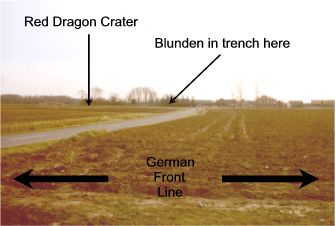

GIVENCHY
EDMUND BLUNDEN AND THE RED DRAGON CRATER
This is a present day photograph of the former location in No Man’s Land of the Red Dragon Crater. Sapper Hackett V.C. lies buried in the field on the right of the picture.
The British front line was situated in the line of trees (running from left to right across the photo.) in front of the houses in Givenchy village.
On the 21st June 1916 the 2nd Bn. Royal Welch Fusiliers took over the section known as the Duck’s Bill on account of the configuration of the front lines at that point. At 2 a.m. the following morning, a German Mine exploded directly under the battalion’s "B" company which lost some 2/3rds of its strength including two officers and the Company Sergeant Major. The resulting crater was about 120 yards long, over 70 yards in width and some 30 feet deep. Under the command of Captain Stanway, a few days later to become the C.O. of the 6th Bn. Cheshire Regt., men of the battalion went forward immediately and repulsed a German raid which followed the blowing of their mine.
Just at the time the mine exploded No 254 Tunnelling Company Royal Engineers was digging a mine-shaft towards the enemy lines. The detonation of the German mine blocked the gallery in which the men were digging and the miners working there were buried alive. Several tunnellers were eventually rescued but Sapper William Hackett refused to leave a wounded comrade still in the gallery. For four days sappers tried to dig their way through the gallery to allow Hackett and his comrade to escape but without success. Sapper Hackett received a posthumous Victoria Cross for his self-sacrifice.
In honour of the Royal Welch’s prompt action in defeating the German raiders (a force of some 150 men) the crater was given the name "Red Dragon Crater" from the design of the Regiment’s cap badge.
On the 7th August Blunden was given the task of restoring a sap (a trench leading to the crater). To his great surprise he was given a working party of 100 men from his battalion (11th Royal Sussex). They completed the task but not without a severe reprimand for Blunden for he was seen by a senior officer carrying a duck-board under his arm: manual work was not appropriate for officers whose job is to supervise and direct.
Copyright © www.1914-18.co.uk, 1999. All rights Reserved